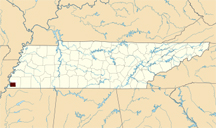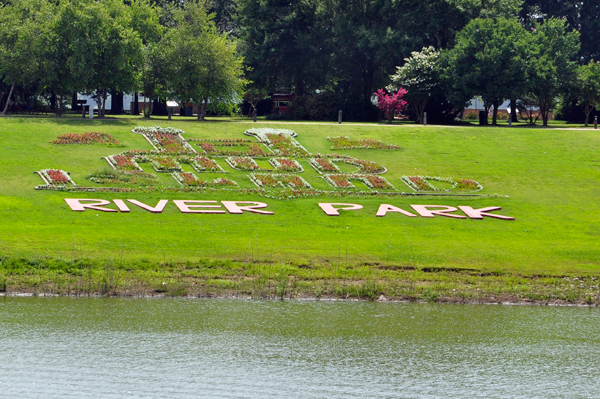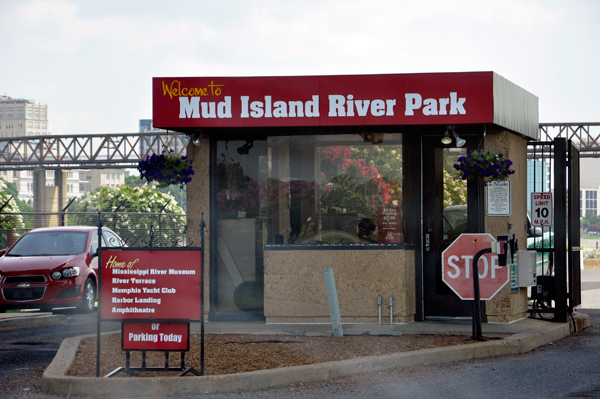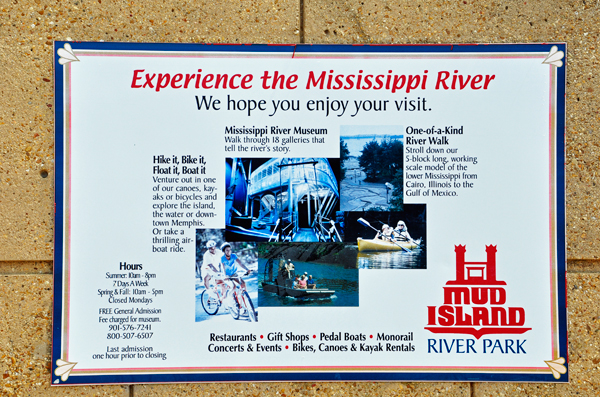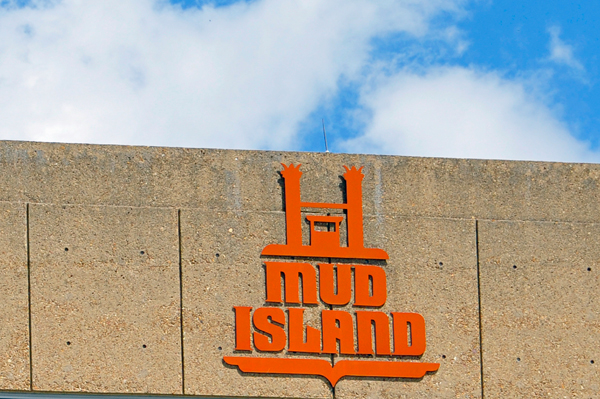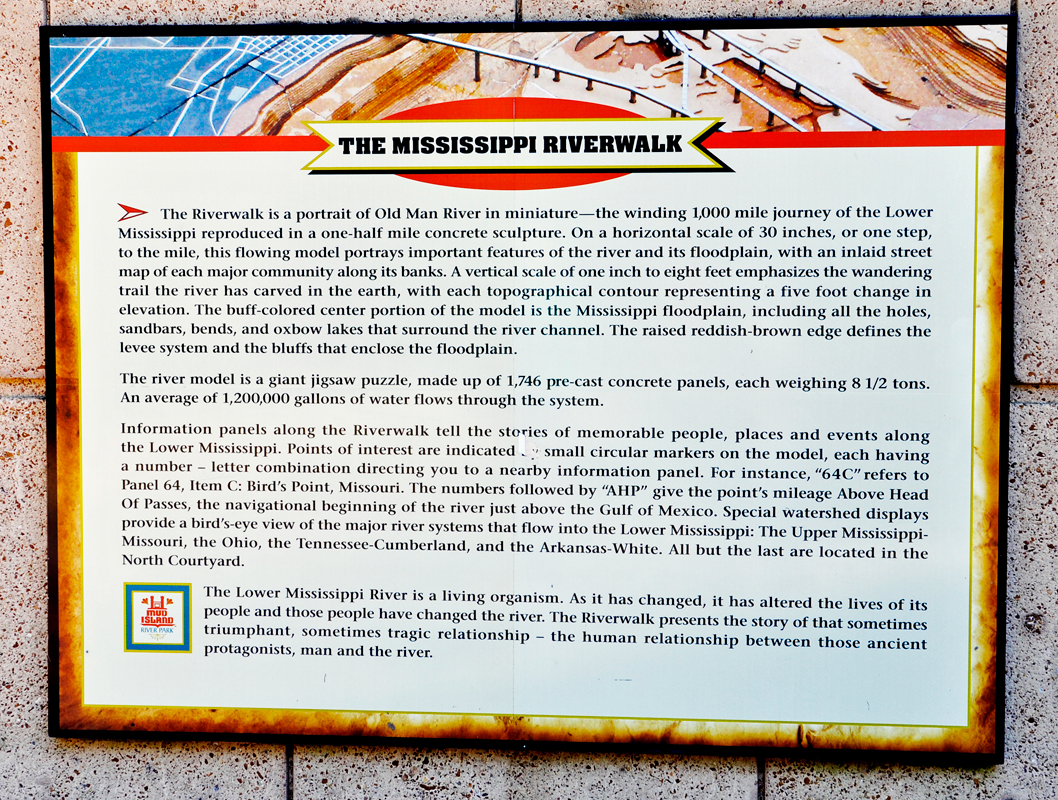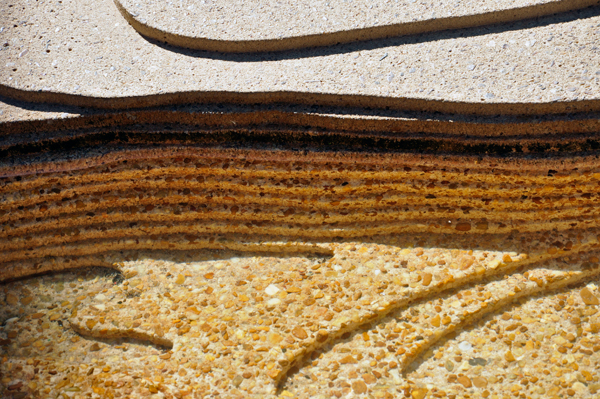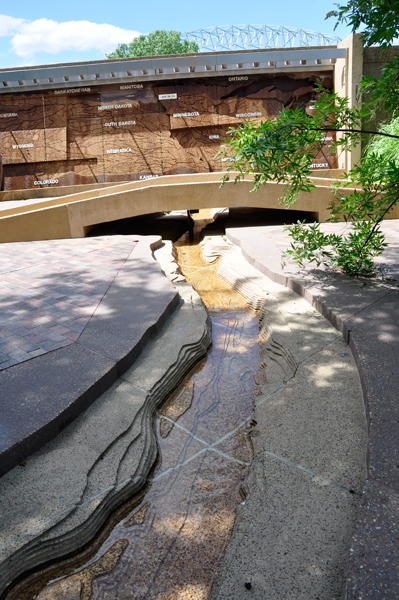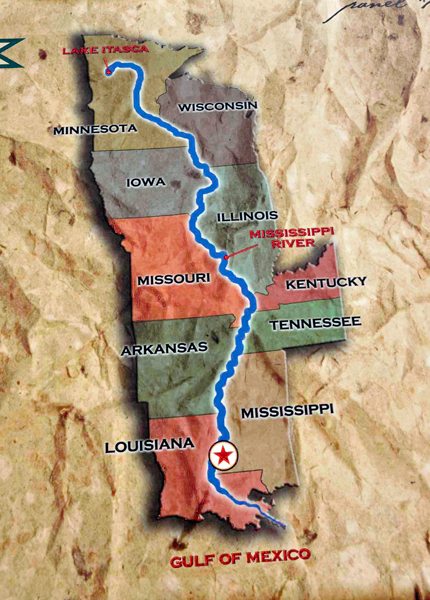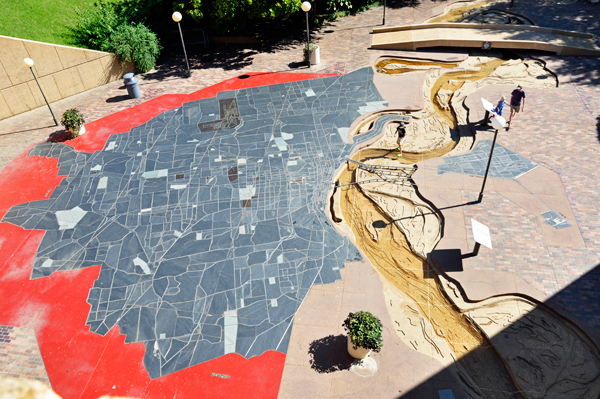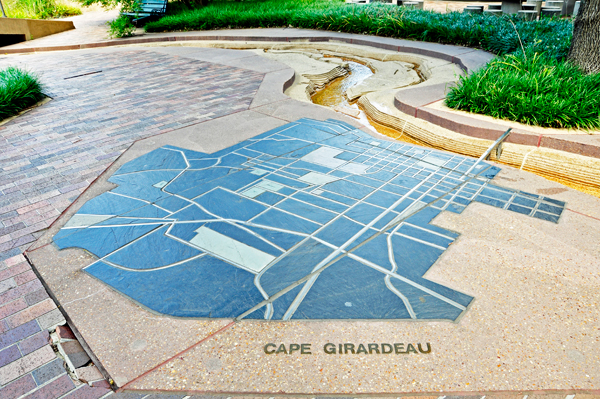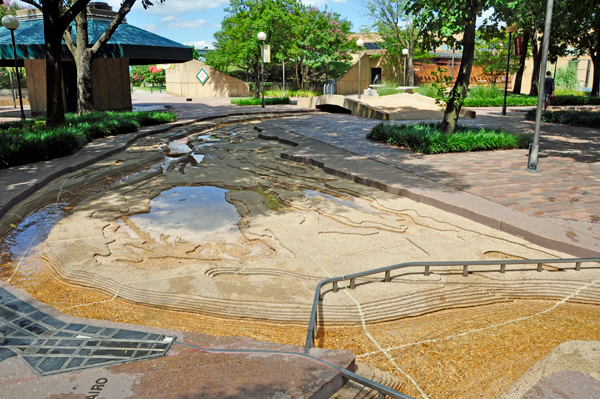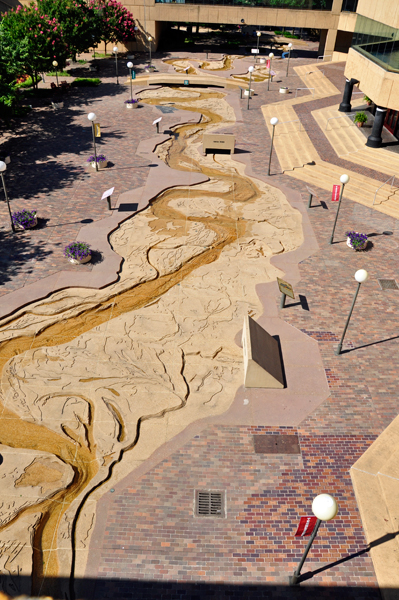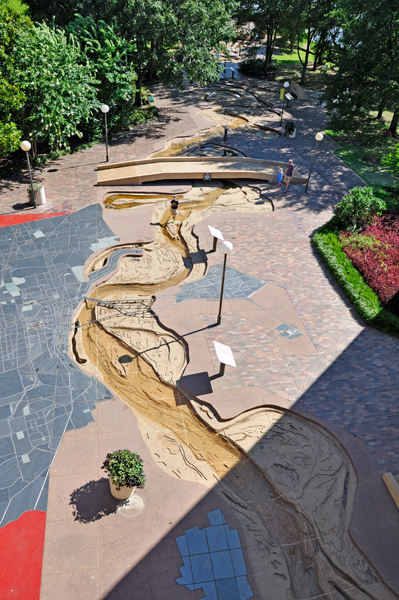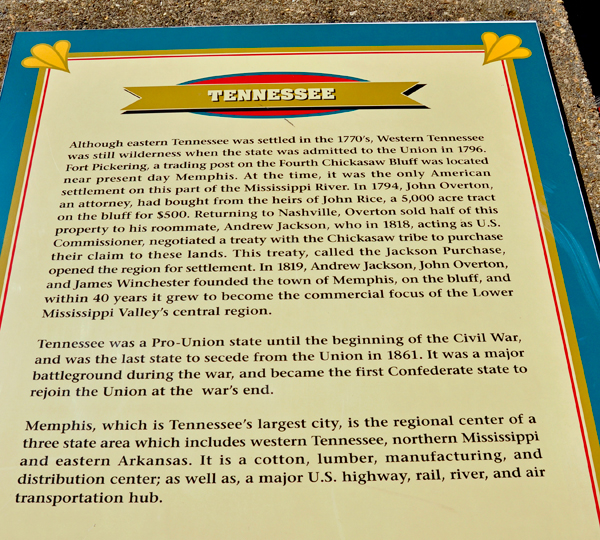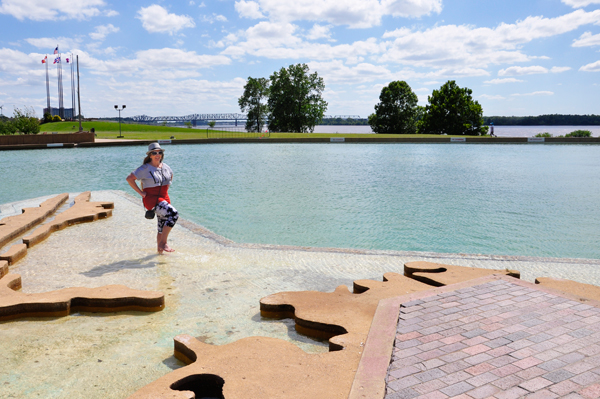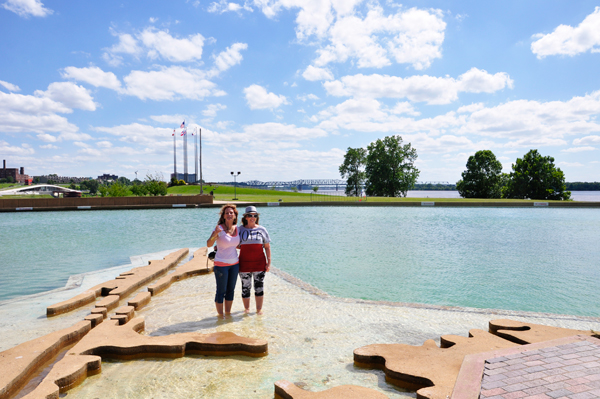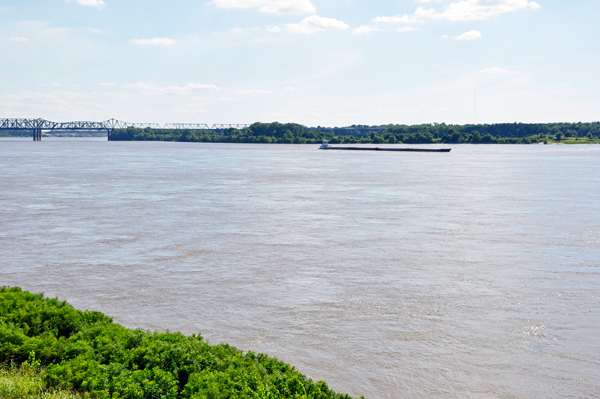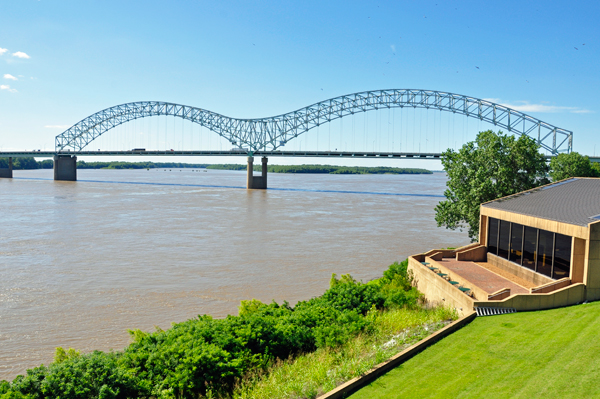 Mud
Island is NOT actually an island. It is a small peninsula,
surrounded by the Mississippi River to the west and the Wolf River Harbor
to the east. In 1960, the Wolf River was diverted so that it flows into
the Mississippi River north of Mud Island, and Mud Island opened to
the public in 1982. It is located within the Memphis city limits, 1.2
miles from the coast of downtown. It is accessible by the Memphis Suspension
Railway (a monorail), or a parking lot and walking into the park. It
cost $6 per car to park. This park is open Tuesday - Sunday 10 A.M.
- 5P.M. The last admission is at 4 P.M. daily. It closes way too early.
The monorail is an extra charge. The food area only had "junk food"
like pizza, hamburgers, hot dogs and french fries. The scale model of
the Mississippi River was the highlight for the two RV Gypsies and Karen
Duquette's sister. Mud
Island is NOT actually an island. It is a small peninsula,
surrounded by the Mississippi River to the west and the Wolf River Harbor
to the east. In 1960, the Wolf River was diverted so that it flows into
the Mississippi River north of Mud Island, and Mud Island opened to
the public in 1982. It is located within the Memphis city limits, 1.2
miles from the coast of downtown. It is accessible by the Memphis Suspension
Railway (a monorail), or a parking lot and walking into the park. It
cost $6 per car to park. This park is open Tuesday - Sunday 10 A.M.
- 5P.M. The last admission is at 4 P.M. daily. It closes way too early.
The monorail is an extra charge. The food area only had "junk food"
like pizza, hamburgers, hot dogs and french fries. The scale model of
the Mississippi River was the highlight for the two RV Gypsies and Karen
Duquette's sister.
|
|
|
|
 After
entering the parking area, the two RV Gypsies walked by an area with
lots of birds on wires, so Lee Duquette started clapping his hands and
all the birds flew away. As the birds returned, Lee clapped his hands
again, and they all flew away again. It was quite amusing. After
entering the parking area, the two RV Gypsies walked by an area with
lots of birds on wires, so Lee Duquette started clapping his hands and
all the birds flew away. As the birds returned, Lee clapped his hands
again, and they all flew away again. It was quite amusing.
|
|
|
Below: Two walls showing the USA states
plus the Mississippi River and its tributaries. |
|
|
|
|
 The Riverwalk is one of the most unique representations of the Mississippi River in the world - a winding 1,000 mile journey of the Lower Mississippi reproduced in a one-half mile concrete sculpture. The sign below gives important information about this giant project. The Riverwalk is one of the most unique representations of the Mississippi River in the world - a winding 1,000 mile journey of the Lower Mississippi reproduced in a one-half mile concrete sculpture. The sign below gives important information about this giant project.
|
|
Below: The photo below is
a close-up of the clear water and the dark brown contour ridges. One
contour ridge equals a five foot vertical depth. |
|
 The Riverwalk is an exact scale model of the Lower Mississippi River flowing from its confluence with the Ohio River at Cairo, Illinois 954 miles south to the Gulf of Mexico. Twenty cities are mapped along the Riverwalk. Concrete wedges locate the main rivers flowing into the Mississippi or show river engineering structures such as floodways. There are four watershed walls which map the entire drainage area of the Mississippi River. The model empties into an acre size Gulf of Mexico. Designed using Corps of Engineers survey and navigational charts. There are 1, 746, 4’ x 8’ concrete sections, which were installed and positioned to allow the water to flow from north to south. The Entire length is 2,000 feet or 5 blocks long. The water level is controlled to match the water level in the real Mississippi River. The Riverwalk is an exact scale model of the Lower Mississippi River flowing from its confluence with the Ohio River at Cairo, Illinois 954 miles south to the Gulf of Mexico. Twenty cities are mapped along the Riverwalk. Concrete wedges locate the main rivers flowing into the Mississippi or show river engineering structures such as floodways. There are four watershed walls which map the entire drainage area of the Mississippi River. The model empties into an acre size Gulf of Mexico. Designed using Corps of Engineers survey and navigational charts. There are 1, 746, 4’ x 8’ concrete sections, which were installed and positioned to allow the water to flow from north to south. The Entire length is 2,000 feet or 5 blocks long. The water level is controlled to match the water level in the real Mississippi River.
|
|
|
Below; On a horizontal scale
of 30 inches to the mile, this portrays important features of the river
and its floodplain with an inlaid street map of each major community
along its banks. |
|
|
|
Part of the 1,000 foot long scale model of the Mighty Mississippi river, done in concrete, and accurate to depth and shape. Locations of major bridges and cities are also represented, either cast in metal, or displayed in a different kind of stone. It is impossible to photograph all of it. Water flows through this "mini-Mississippi", and kids love it. They wade through it, and some get very wet, although parts of it are narrow and the contour ridges can be sharp. The river flows all the way past "New Orleans", and into the "Gulf of Mexico". Lake Ponchetrain is represented, as well. The "Gulf" is a 4-6 foot deep pool at the end of the river, where you can rent paddle boats.
|
|
|
|
|
Below: The "1,000" mile journey concludes at the Gulf
of Mexico, a one-acre enclosure that holds 1.3 million gallons of
water. There, visitors can enjoy a leisurely pedal boat ride around
the Gulf area with the Memphis skyline in the background. Karen Duquette
enjoyed cooling her feet in the water.
|
|
Below: Karen Duquette and her sister Ilse Blahak, who
is a Special Ed school teacher and lives in southern California. Ilse
kept saying that she wished she could bring her students here. Ilse
hated the outfit Karen Duquette was wearing, and told her so.
|
|
|
Below: Views of the Mississippi River and very long barges.
|
|
|
Note: In 2015, the two RV
Gypsies went to the real Mississippi Headwaters in Minnesota, which
is the where the Mississippi River actually begins its 2,552-mile journey
to the Gulf of Mexico. Those photos can be found by
clicking here - but if you do so, please return to this page via
one of the links at the bottom of that page to continue on in 2014. |
|
|
|
|

